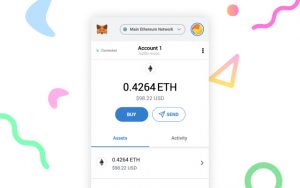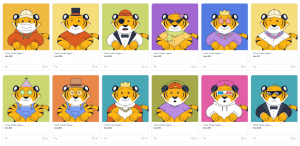Today you will learn how to create NFT and make some cash in crypto
Non-fungible tokens, or NFTs, are exploding in popularity these days. People are paying big money for these unique collectible cryptocurrency assets. One NFT by the digital artist known as Beeple sold for a jaw-dropping $69 million in early 2021, while many others have fetched multimillion-dollar sales prices.
The potential for big money is leading more people to create NFTs in the hope of cashing in on the current craze. Here’s a step-by-step guide on how to make (i.e., mint) and sell an NFT.
1. Pick your item
Let’s start with the basics. If you haven’t already done so, you’ll need to determine what unique digital asset you want to turn into an NFT. It can be a custom painting, picture, music, video game collectible, meme, GIF, or even a tweet. An NFT is a unique digital item with a sole owner. That rarity gives an NFT value.
Make sure that you own the intellectual property rights to the item you want to turn into an NFT. Creating an NFT for a digital asset you don’t own could get you into legal trouble.
2. Choose your blockchain
Once you’ve selected your unique digital asset, it’s time to start the process of minting it into an NFT. That begins by determining the blockchain technology you intend to use for your NFT. The most popular among NFT artists and creators is Ethereum (CRYPTO:ETH). Other popular options include Tezos, Polkadot, Cosmos, and Binance Smart Chain.
3. Set up your digital wallet
If you don’t already have a digital wallet, you’ll want to set one up to create your NFT since you’ll need some cryptocurrency to fund your initial investment. The wallet will provide you with access to your digital assets. The top NFT wallets include Metamask, Math Wallet, AlphaWallet, Trust Wallet, and Coinbase Wallet.

Once you set up your digital wallet, you’ll want to buy some cryptocurrency. Most NFT platforms accept Ether, the cryptocurrency of the Ethereum blockchain platform. If you already own some cryptocurrency elsewhere, you’ll want to connect it to your digital wallet so you can use it to create and sell NFTs.
4. Select your NFT marketplace
Once you have a digital wallet and some cryptocurrency, it’s time to start creating (and, hopefully, selling) your NFT. For that, you’ll need to choose an NFT marketplace. Some of the top NFT marketplaces include OpenSea, Axie Marketplace, Larva Labs/CryptoPunks, NBA Top Shot Marketplace, Rarible, SuperRare, Foundation, Nifty Gateway, Mintable, and ThetaDrop.

You’ll need to research each NFT marketplace to find a platform that’s a good fit for your NFT. For example, Axie Marketplace is the online shop for the top NFT game Axie Infinity. Meanwhile, NBA Top Shot is a basketball-focused marketplace. It’s also important to note that some marketplaces require their own cryptocurrency. Rarible, for example, requires Rarible (CRYPTO:RARI).
OpenSea is usually a good place to start. It allows you to mint your own NFT, and it’s a leader in NFT sales. The NFT marketplace sold $3.4 billion worth of NFTs in August 2021 alone.
After selecting your NFT marketplace, you’ll need to connect it to your digital wallet. That will allow you to pay the necessary fees to mint your NFT and hold any sales proceeds.

5. Upload your file
You’re now finally ready to mint your NFT. Your chosen NFT marketplace should have a step-by-step guide for uploading your digital file to their platform. That process will enable you to turn your digital file (a PNG, GIF, MP3, or other file type) into a marketable NFT.
6. Set up the sales process
The final stage in the NFT minting process is to decide how you want to monetize your NFT. Depending on the platform, you can:
- Sell it at a fixed price: By setting a fixed price, you’ll allow the first person willing to meet that price to buy your NFT.
- Set a timed auction: A timed auction will give those interested in your NFT a time limit to submit their final bid.
- Start an unlimited auction: An unlimited auction doesn’t set a time limit. Instead, you have control to end the auction whenever you want.
You’ll need to determine the minimum price (if you set up an auction), set your royalties to continue cashing in on your NFT if it resells on the secondary market, and how long to hold an auction (if timed). Keep fees in mind when setting the minimum price because you could lose money on your NFT sale if you set the price too low.
Unfortunately, the fees to mint and sell an NFT can be costly and confusing. Depending on the platform and pricing, you could pay a listing fee, an NFT minting fee, a commission on the sale, and a transaction fee to transfer money from the buyer’s wallet to yours. Fees also can fluctuate due to the volatility in cryptocurrency pricing. Because of that, it’s important to take a close look at the costs you’ll have to pay to mint and sell your NFT to make sure they’re worthwhile.
Making NFTs can be a profitable investment
The sale prices of NFTs are rising as they gain in popularity. Consequently, NFT creators can make a lot of money. However, not all NFTs will even sell, let alone make their creator any money, given all the fees involved with minting and selling NFTs. Due to the costs, you need to prepare for the possibility that you could lose money on your NFT creation. The best way to avoid a loss is to make sure you sell an NFT that others will find valuable and set a minimum price that will more than offset any associated fees.
